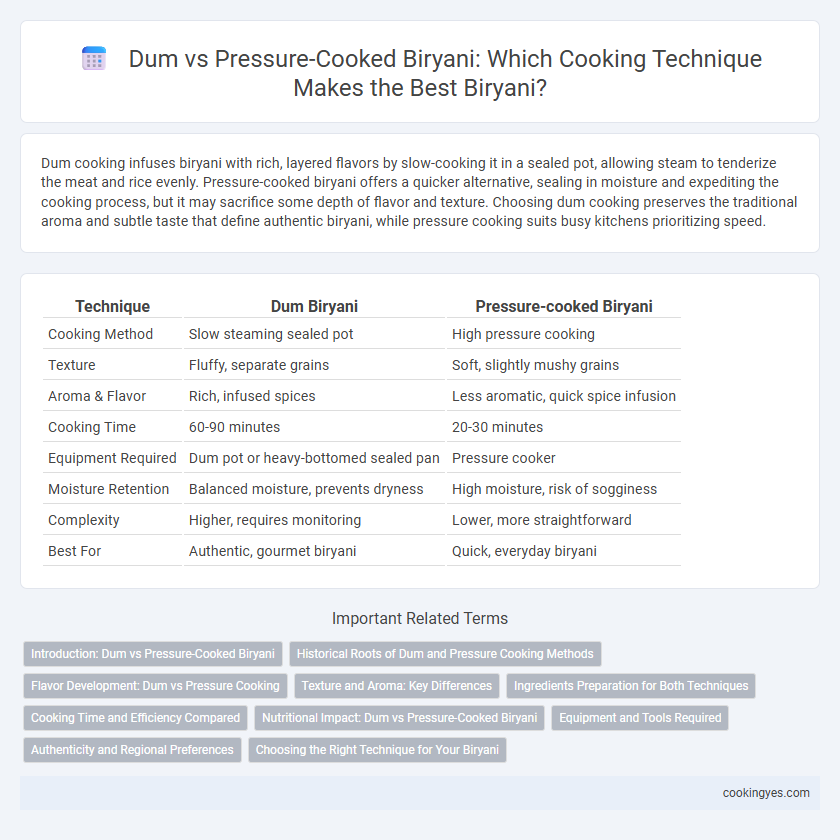Dum cooking infuses biryani with rich, layered flavors by slow-cooking it in a sealed pot, allowing steam to tenderize the meat and rice evenly. Pressure-cooked biryani offers a quicker alternative, sealing in moisture and expediting the cooking process, but it may sacrifice some depth of flavor and texture. Choosing dum cooking preserves the traditional aroma and subtle taste that define authentic biryani, while pressure cooking suits busy kitchens prioritizing speed.
Table of Comparison
| Technique | Dum Biryani | Pressure-cooked Biryani |
|---|---|---|
| Cooking Method | Slow steaming sealed pot | High pressure cooking |
| Texture | Fluffy, separate grains | Soft, slightly mushy grains |
| Aroma & Flavor | Rich, infused spices | Less aromatic, quick spice infusion |
| Cooking Time | 60-90 minutes | 20-30 minutes |
| Equipment Required | Dum pot or heavy-bottomed sealed pan | Pressure cooker |
| Moisture Retention | Balanced moisture, prevents dryness | High moisture, risk of sogginess |
| Complexity | Higher, requires monitoring | Lower, more straightforward |
| Best For | Authentic, gourmet biryani | Quick, everyday biryani |
Introduction: Dum vs Pressure-Cooked Biryani
Dum biryani involves slow cooking sealed pots to retain moisture and infuse rich flavors, resulting in aromatic, tender rice and perfectly cooked meat. Pressure-cooked biryani uses high heat and pressure to drastically reduce cooking time but may compromise the texture and depth of flavors. Traditional dum method enhances the layering of spices and ingredients, creating a more authentic and visually appealing biryani experience.
Historical Roots of Dum and Pressure Cooking Methods
The Dum cooking technique, originating during the Mughal era, involves slow steaming sealed pots to infuse spices deeply into the rice and meat, preserving aroma and texture. Pressure cooking, a modern innovation, significantly reduces cooking time by using high-pressure steam but often sacrifices the layered flavors characteristic of traditional Dum biryani. Historical roots emphasize Dum as an artisanal process rooted in royal kitchens, whereas pressure cooking adapts biryani for contemporary convenience without replicating the intricacies of the original method.
Flavor Development: Dum vs Pressure Cooking
Dum cooking preserves the intricate layers of aroma and spices by slow-cooking biryani with steam trapped inside a sealed pot, allowing flavors to deeply infuse the rice and meat. Pressure cooking, while significantly reducing cooking time, often produces a less nuanced flavor profile due to the rapid cooking process and steam release. Flavor development under dum technique is more pronounced and complex, enhancing the traditional richness and texture characteristic of authentic biryani.
Texture and Aroma: Key Differences
Dum-cooked biryani retains a layered texture where each grain remains separate and absorbs rich, aromatic spices slowly, resulting in a fragrant and fluffy dish. Pressure-cooked biryani tends to have a softer texture with spices infused quickly, often compromising the distinctness of rice grains and subtle aroma. The slow steam of dum technique preserves essential oils and flavors, enhancing the biryani's depth compared to the intense heat of pressure cooking.
Ingredients Preparation for Both Techniques
Dum cooking for biryani involves slow cooking marinated meat and partially cooked rice in a sealed pot, allowing flavors to deeply infuse and retain moisture. Pressure-cooked biryani uses high heat and pressure, which speeds up the cooking process but requires ingredients like meat and rice to be cut into smaller pieces or parboiled to ensure even cooking. Proper marination with yogurt, spices, and herbs is essential for both techniques to enhance flavor and tenderness.
Cooking Time and Efficiency Compared
Dum cooking for Biryani involves slow steaming on low heat, typically taking 45 to 60 minutes, which allows flavors to develop deeply and results in a tender, aromatic dish. Pressure-cooked Biryani drastically reduces cooking time to around 15-20 minutes by using high pressure and temperature, making it efficient for quick meals while slightly compromising on texture and layering of flavors. Efficiency-wise, the pressure cooker offers a faster solution ideal for busy kitchens, whereas the traditional Dum method prioritizes authentic taste and texture through prolonged cooking.
Nutritional Impact: Dum vs Pressure-Cooked Biryani
Dum-cooked biryani retains more nutrients due to the slow cooking process, preserving vitamins and minerals by minimizing heat exposure. Pressure-cooked biryani, while faster, may cause a greater loss of water-soluble nutrients like vitamin B and C due to higher temperatures and steam pressure. Choosing dum cooking enhances nutritional value and flavor by maintaining the integrity of ingredients throughout the cooking duration.
Equipment and Tools Required
Dum biryani requires a heavy-bottomed pot or handi with a tight-fitting lid to trap steam, along with a heat diffuser to ensure slow, even cooking over low heat. Pressure-cooked biryani demands a robust pressure cooker designed to withstand high pressure and rapid cooking, reducing overall preparation time but sacrificing some texture and aroma. Essential tools for dum are a muslin cloth to seal the pot and allow gentle steaming, whereas pressure-cooked biryani relies on the pressure release valve and safety mechanisms integral to the cooker.
Authenticity and Regional Preferences
Dum cooking preserves the authentic aroma and delicate texture of biryani by slow-cooking rice and meat in sealed pots, a traditional method favored in Hyderabad and Lucknow. Pressure-cooked biryani offers faster preparation but may compromise the layered flavors and tender juiciness characteristic of authentic dum biryanis. Regional preferences strongly favor dum biryani for festive occasions, emphasizing patience and purity in taste over convenience.
Choosing the Right Technique for Your Biryani
Dum cooking preserves the aromatic flavors and tender texture of biryani by slow-cooking sealed with steam, ideal for layering spices and marinated meat. Pressure cooking speeds up the process, locking in moisture but may compromise the depth of flavor and delicate rice grains. Selecting between dum and pressure-cooked methods depends on balancing time efficiency with the desired authenticity and texture of traditional biryani.
Dum vs Pressure-cooked for Biryani technique Infographic

 cookingyes.com
cookingyes.com